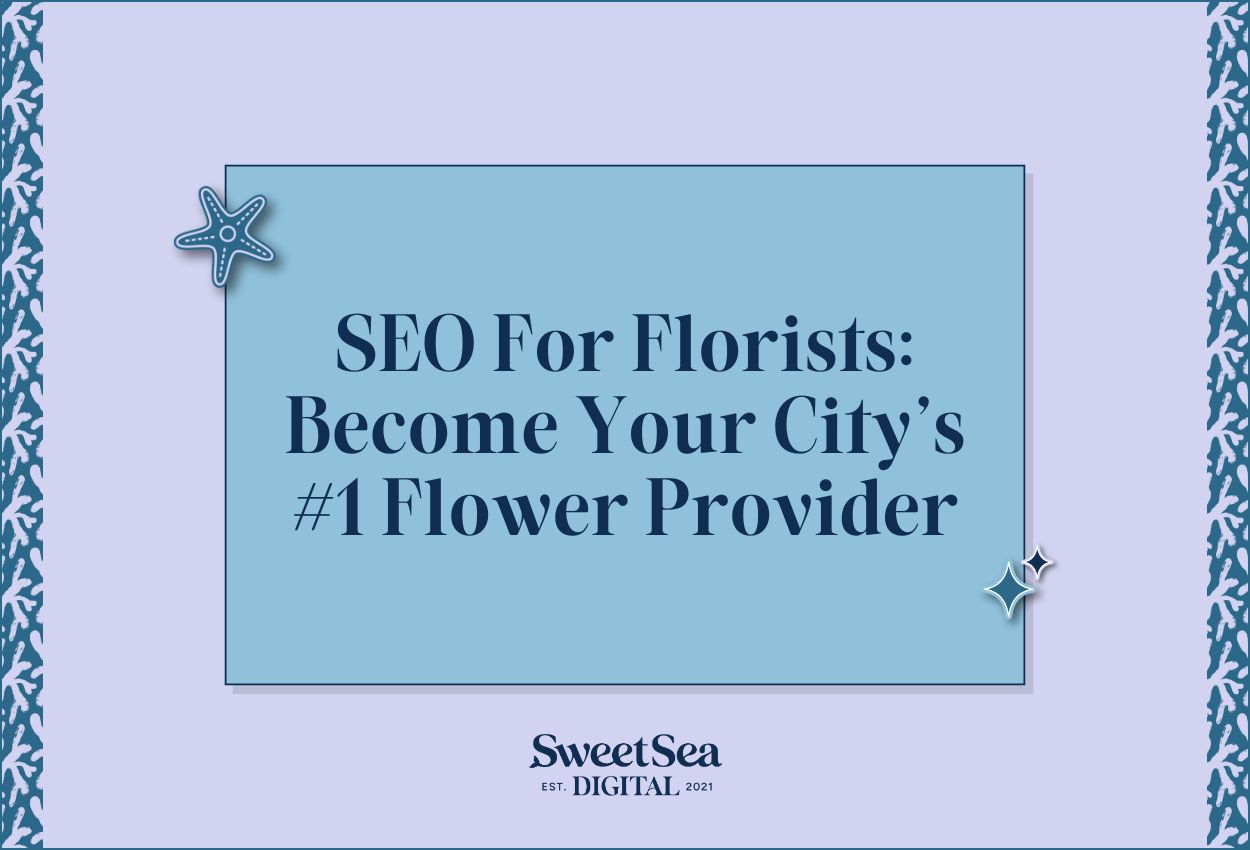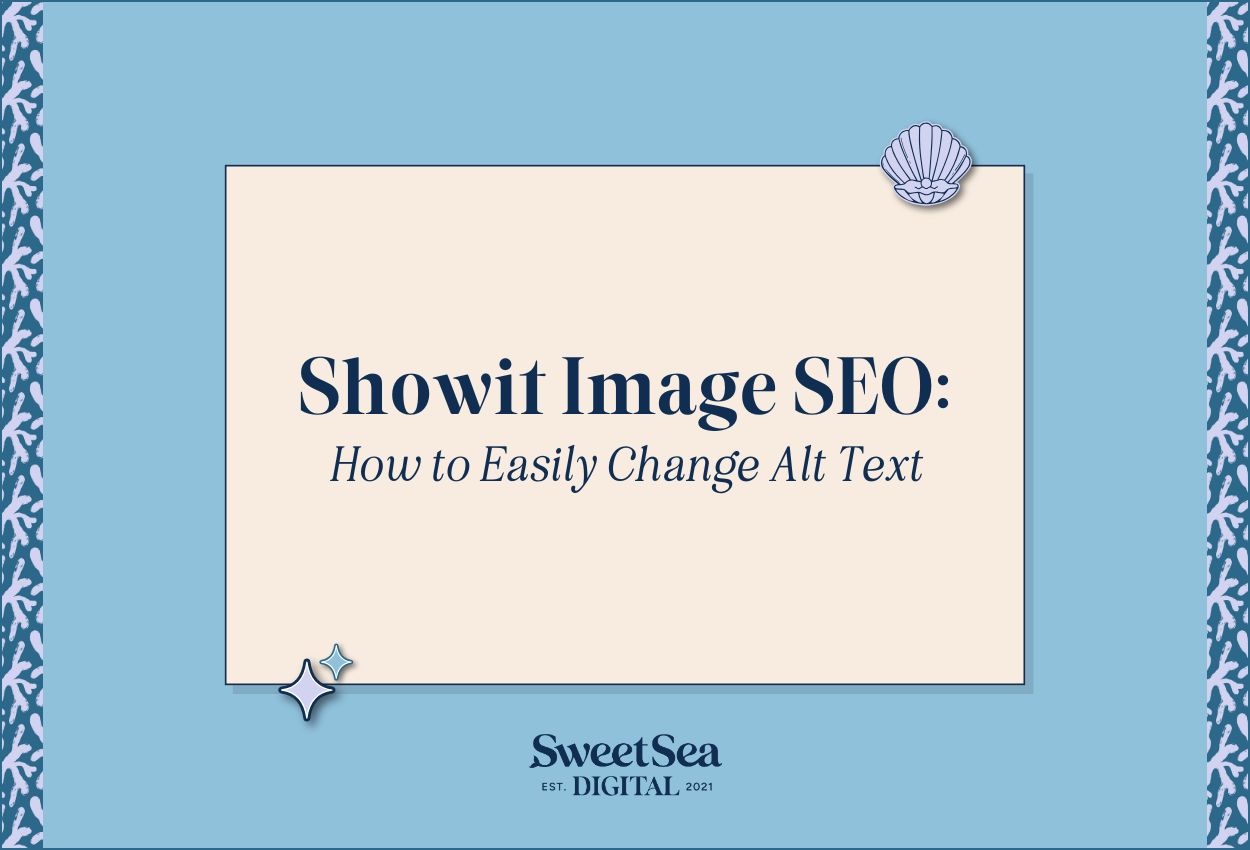Blog vs Instagram: What’s Better to Start? (2025)
By Seren Nurgun,
Founder of SweetSea Digital
By Seren Nurgun
Jan 27, 2025
Salt Your SEO:
Kickstart Your SEO With These 5 Easy Steps!
Struggling to decide between starting a blog or starting an Instagram account? You’ve probably been weighing all of the pros and cons but still aren’t sure which one would pay off more for you. With so many ways to market your business, it’s smart to want to diversify your marketing – the struggle is we all only have so much time and resources.
So, given your specific circumstances, how do you decide which one will be the better (let’s be real: the most lucrative) investment?
The main difference between Instagram and blogging is that the former requires you to post at least a couple of times a week to keep momentum going, whereas the later grows faster with weekly publishing but doesn’t force you to do that in order to grow and keep the algorithms happy. While building an audience on Instagram is more likely to lead to a better short-term return on investment (ROI), blogging is more likely to lead to a better long-term ROI. As someone who’s been in your shoes, carefully going through the different nuances involved in making this decision will help you decide what’s the absolute best for your unique business and needs.
What You Need to Start an Instagram Account
Instagram is now the third most-used social platform in the world (tied with Whatsapp), hosting 3 billion active users as of April 2024. That’s about 25% of the world’s entire population!
Because of the platform’s heavy emphasis on photo and video content, it might seem like a tough platform for brands that don’t have any kind of visual product.
But even business-to-business (B2B), personal brand-based businesses, SaaS founders, and location-based businesses are able to benefit from Instagram. Even though it’s not as powerful as it once, the platform still gives good content the ability to reach a lot of people. You’re just going to need to be strategic with your content plan in order to stand out and grow.
Not to mention, using Instagram for business can be a good way to find clients and customers if they’re already spending their time there. If your target audience is known to hang out a lot on Instagram, you can bet it’s probably a good idea to have an active presence on the app.
According to HubSpot’s Social Media Trends 2024 Report, Instagram is the 3rd social media channel that provides marketers with the highest ROI, closely behind YouTube and Facebook. It helps to drive awareness, nurture potential clients and customers, increase sales over time, and keep an open line of communication between your business and people who like your business.
While posting regularly is the holy grail of growing on Instagram, effective on-platform marketing tactics like collaborations, influencer shoutouts, affiliate promotions, contests/giveaways, and branded hashtags can also help you grow faster.
Here’s what you’ll need to start and grow an Instagram account:
Ability to Take Photos, Create Graphics and/or Videos, and Write Captions (Or Outsource)
You don’t want to be throwing spaghetti at the wall, so whichever marketing channel you choose will need to have its own strategy.
Since Instagram is such a visual platform, your content will need to be visually appealing, unique, and engaging for your target audience.
This means you need to have access to a quality camera (your phone works!), the skills necessary to create and edit graphics and videos (a basic skill level is enough!), and the ability to write captions (if you’re not a writer, hello ChatGPT!).
If you lack the skills and/or time, like many business owners juggling a bunch of things, outsourcing your content creation, caption writing, and posting could be a viable option.
However, it all depends on your budget and how much control you’re willing to give away!
Ability to Post in the Moment or Schedule Posts in Advance (Or Outsource)
Once you’ve got your quality content sorted, you’re going to need to post regularly either in the moment or by scheduling posts in advance.
And you’re in luck! Instagram has introduced scheduling posts from within the app itself!
You can post and schedule different types of content (reels, feed posts, lives, and stories) which all have different purposes and get different engagement rates.
Planning and scheduling your content ahead of time will free up your time later to reply to comments and DMs and dedicate more energy to meaningful engagement.
But it’s easier said than done! One method that many 6-figure and up entrepreneurs swear by is batching. That just means doing a couple week’s worth of caption writing in one sitting, all graphic creation in another single sitting, etc.
Time in Your Schedule to Engage Daily
As a business owner wearing all the hats (including marketing) looking to boost clicks, you’re going to need to put in the time to engage with your audience. You have to be social on social media!
Daily engagement is key to building your brand’s success on Instagram, but it’ll require your ongoing commitment. I recommend creating a daily repeating 15-minute block in your schedule dedicated to engaging both with your followers, people you follow, and totally brand new people.
If you’re savvy with creating quality visual content and writing captions, and have the passion to engage daily with your audience (or outsource the above), then Instagram might just make the most sense for you.
Instagram can also be a good option for small or new businesses who have the time to dedicate it, or those with a strong visual product (like e-commerce businesses) who are just starting to increase awareness and trying to grow their brand as fast as possible.
Even big established businesses can see massive results from reaching a wider audience through social media.
What You Need to Start a Blog
In today’s social media-obsessed world, blogging might seem old-school.
But just because it’s been around a while doesn’t mean it’s not still effective. The latest 2024 statistics show that 61% of Americans spend 3X more time consuming blog content than emails. In other words, that means over 42 million Americans read blog posts more than they read emails!
Blogging, via search engine optimization (SEO), attracts free organic traffic – people who are looking for specific answers, products, or information, and who are willing to sit and read online.
While it’s slowly getting harder over time to rank articles high on Google because of increasing competition and more complex Google algorithms, there’s no doubt that marketing through search engines can be extremely profitable. Having a blog increases your chances of ranking higher in search by 434%!
Blogs can also be extremely lucrative in the long-term, particularly if you create the backend mechanisms to generate passive income over time.
Here’s what you’ll need to start and grow a blog:
Solid Business Foundations
To build a successful blog for your business, you’re going to need a solid business foundation to inform your SEO strategy.
If you’re at square one, your business foundation includes defining your target market, deciding on what to sell/create/offer, knowing why your target market would want to buy, figuring out your messaging and positioning, and setting your prices to be fair and profitable.
Without knowing what you want to offer your target market, it’s kind of pointless to invest in blogging because you might end up publishing 10 awesome blog posts, pivoting your business, and then having to reshape those posts to fit your new foundations (if they can even be reshaped in the first place).
A Website
If you don’t already have a website, you’ll need to spend a bit of money and have basic tech skills to get it up and running. Don’t worry, this is totally doable! Even if you’re not tech-savvy AT ALL, you can definitely figure this out (Google and YouTube are your friend).
There are lots of tutorials on YouTube to help you get started, but you’ll basically need to buy a domain (~$10 for a year) and sign up to a website building platform like WordPress, Squarespace, Showit, Webflow, WIX, etc.
Aside from WordPress, the main platforms tend to automatically come with web hosting, security and privacy features, and branded email. Getting started, you don’t need more than that! If you’re not tech-savvy, I absolutely don’t recommend WordPress. My two favorites that are extremely easy to use and get started with are Showit and Squarespace.
If you already have a website, then all you need to get started blogging is creating a blog homepage (that typically lives at yourdomain.com/blog) and creating a templated single blog post design.
Pro Tip: Don’t create your blog on a subdomain like blog.yourdomain.com! It should be yourdomain.com/blog. That’s because Google treats subdomains as a completely different website than your main one so it’d be like starting a website from scratch.
A vital benefit of blogging on your own website is you own your content, control it, and get all of the benefits of it. On Instagram, algorithms change really fast, new features force you to adapt, accounts get randomly shut down – it’s a lot messier than Google SEO!
The Ability to Write Blog Posts (Or Outsource)
As blogging is a form of written media, you’re going to need to have the skills to write helpful, high-quality content. Or you’ll need to outsource blog management.
As a business, you’ll want your blog posts to help guide readers towards solving their problems through what you sell. You need to know your subject area in-depth to build trust and know what you’re writing about.
Blogging regularly (I recommend 1x a month for new solopreneurs) is the best way to show Google you mean business. Google absolutely loves fresh content! Publishing 5 blog posts and then taking a year off isn’t exactly the best strategy. Like Instagram, it requires commitment to see results.
If you’re planning to outsource blog writing, findings from Marketing Insider Group show that publishing 2 to 4 blog posts per week bring in the best traffic and conversion results.
Outsourcing high-quality blog post creation isn’t cheap but it might be worth it in the long-term if you have the funds and don’t have the time or capacity to write yourself! This is actually my signature service (one I absolutely love doing!).
If people are searching for what you offer on Google and you’re an established business or brand looking to scale, adding a blog to your marketing strategy would be the right choice for you. New businesses or start-ups also see positive results in the long-term, but if funds are tight I don’t recommend putting all of your marketing eggs into one basket at the beginning.
(If you think starting a blog might be the best option for you, grab my free SEO guide for beginners. It’ll walk you through 5 steps you’ll need to lock-in before you start!)
Pros of Starting a Blog
- Drives free, highly targeted organic traffic to your website
- Builds brand awareness and nurtures potential clients and customers
- Gives you complete ownership of your content
- Returns a larger profit in the long-term
- Can grow your email list on autopilot
- Leads to more consistent sales
Cons of Starting a Blog
- Can be time-consuming to set up and maintain
- Requires a high level of writing skills and the ability to publish consistently (or the financial ability to outsource this)
- Takes a couple of months to kick into gear
- Has a delayed feedback loop
Blogging might be for you if you want to have complete freedom and control over your content, your business foundation is solid, and you have the technical know-how required to set up and run a website.
If you’re an established business owner looking to set up mechanisms that’ll bring in organic traffic for years to come, blogging is the way to go.
Pros of Starting an Instagram Account
- Quick and easy to set up
- Gives you fast feedback on content
- Quicker and higher ROI in the short-term
Cons of Starting an Instagram Account
- Requires daily engagement with a less interested audience
- Builds more surface-level relationships that you have to nurture
- Requires posting everyday to stay relevant
- Has the risk of Instagram randomly shutting down your account
- Don’t have ownership of your content
- Algorithms can change how you reach your audience overnight
Instagram might be better for you if you’re an outgoing, visual person who loves sharing their thoughts and building relationships.
It might also be for you if you’re looking to get your name out there quickly and start building public momentum.
Whatever your business goals, a strong online presence in today’s world is vital.
A blog can be a bit tech tricky and definitely requires maintenance.
But you have more control over the content and, with the right marketing strategy, your growing audience will likely be more authentic. As a result, you’ll see a higher ROI in the long term.
Instagram has a much shorter feedback loop, but requires daily engagement with your followers.
You’ll have a lot less control over the content you post, but the platform is free and easier to use with the potential to reach a lot of people fast.
Whichever platform you go for – Instagram, or a blog – it’s going to be an extremely individual choice. What it will all come down to is your own skills, resources, and capacity, as well as your long and short-term goals and needs! Good luck!
Seren Nurgun
SEO pro and founder of SweetSea Digital, Seren has proudly generated over 278,000 organic clicks from Google and worked with awe-inspiring 6 and 7-figure business owners. Ethical, sustainable marketing is her jam.
Read These Next
Before you go any further…
Hi! I’m Seren, the writer!
Hi! I’m Seren, the writer!
An SEO pro since 2021, I’ve generated over 278,000 organic clicks from Google and worked with 6 and 7-figure business owners. Starting, running, and growing a business definitely isn’t the easiest thing you’ll ever do (to put it lightly), so this treasure trove of blog posts is purely focused on making your life that much easier. You’ve found one of my favorite places on the internet, so I won’t hold you any longer - happy reading!
But first!
Start your SEO journey on strong footing.
Benefit from the free Salt Your SEO guide, weekly newsletters with actionable tips, and some promotions you might not want to miss.
We’re not jerks! Your email will never be spammed, sold, or otherwise treated poorly.

FREE
GUIDE
A Boutique SEO Agency For Woman-Led Online & Local Businesses
A Boutique SEO Agency
For Woman-Led Online
& Local Businesses
who are ready to leverage the world’s
#1 search engine & make sales on repeat.
Navigate
Learn
Let's Connect
© 2021-2025 SWEETSEA DIGITAL, LLC
Brand Photography by Halle Alessia
SITE DESIGN BY CREATE & WANDER
Operating from the unceded ancestral homeland of the Tequesta people
Because we value your trust, we want to share that this page may contain unique affiliate links, which means that we may receive a financial exchange (at no cost to you) if you make a purchase. We only recommend the tools that we actually love and 100% ethically stand behind (because you deserve the best!).


